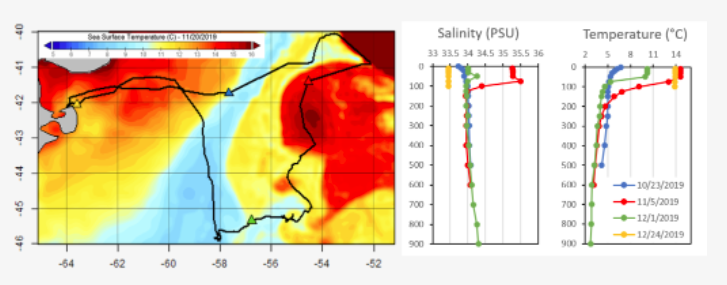CTD monitor
CTD
Picture a column, starting at the surface of the ocean and descending to the ocean floor. Conceptualised by the discipline of oceanography, this is the area delineated for measuring qualities of water, an architecture of modernity.
A CTD is an instrument commonly used by oceanographers, which measures conductivity, temperature and depth within this region of water. It can gather high resolution data, however it can only do one cast at a time on the sample site – and many casts are needed to provide a picture of an ocean environment. By measuring hydrostatic pressure, compression, pressure, and local gravity field at a certain latitude, depth can be calculated. Then conductivity, temperature and depth are used to calculate water salinity. A CTD utilises sampling bottles, which close at different depths, and by dragging the measure upwards through the water, a profile of the water column is created.
This logic follows long history of the way that the seascape has been imagined by different disciplines of Western science. CTD instruments which now rise through these vertical delineations, are preceded by hemp ropes, weighted with lead, which would be dropped from the side of a ship. As the rope dropped, it ran through the hands of the sailors. Knots on the rope, representing fathoms, were called out, and marked down with a quill pen.
From the seabed upwards
“I have been asked by the Captain to try to explain to you as well as I am able, what is the object of our expedition & what we are doing from day to day. I need not remark that it gives me pleasure to do so, for we are to be common shipmates for the next few years & doubtless each one has some interest in the work, the results, if successful, will be creditable to us all. In the first place I must tell you that the bottom of the sea occupies an area of the globe, & this immense portion has been a sealed book to the human race. We have a comparatively accurate notion of the land; we know the geology and the Natural History of much of the countries of the earth, even Africa and Australia are becoming annually more known to us; and the indomitable energy of man is slowly but surely bringing each country into what I may call the regular routine, & causing it to contribute somewhat to the comfort & happiness of the rest; inasmuch as their productions whether natural or artificial, whether as necessary or more generally as (luxuries) are spread in this manner over the world, & in this way conduces to the general happiness of mankind. One reason why our ancestors did nothing towards lifting the soil from the sea bottom was because it was thought that no object could be gained by so doing; and the difficulties in the way were deemed insurmountable. For it was thought, and with reason, that nothing living could exist at a greater depth than about 400 fathoms. Now you all know that when an empty bucket is put over the ships side & allowed to sink down a little distance, what difficulty there is in hauling it up, & what a resistance is offered by the weight of water on the top of it. That resistance increases the lower we go; so that if a man was placed at the bottom...”
Wildlife computers

Figure 2—The track of a southern elephant seal tagged with a prototype SCOUT-CTD tag at Península Valdés. The seal migrated east over the course of a month into an area with high salinity, warm-core eddy formed by the Brazil Current before turning back toward the coast. The SST image is from the midpoint of the migration. While temperatures warmed over the two-month period, warmer, low-salinity water near the coast, the northward cold-water current in the center, and warmer high-salinity water offshore were persistent throughout the track. Colored triangles on the map indicate the locations corresponding to the profiles in the right panels.
https://wildlifecomputers.com/blog/promising-field-trial-results-prototype-scout-ctd-tags-transmit-thousands-of-temperature-and-salinity-profiles/
Lecture by Thompson to crew of Challenger, 1873
Substance of Professor Wyville Thompson's Lecture, to the ship's company of H.M. Ship, Challenger, on the Geography of the sea & the object of the challenger expedition. With remarks on the progress hitherto made.
Collection: Scripps Institution of Oceanography Letters, Clippings, Ships' Logs